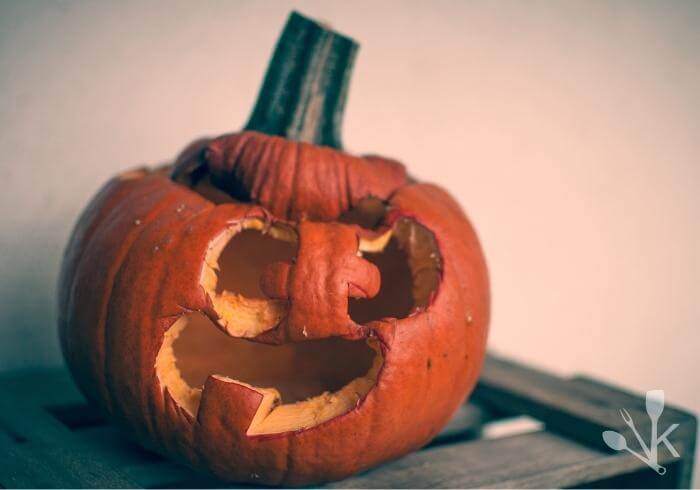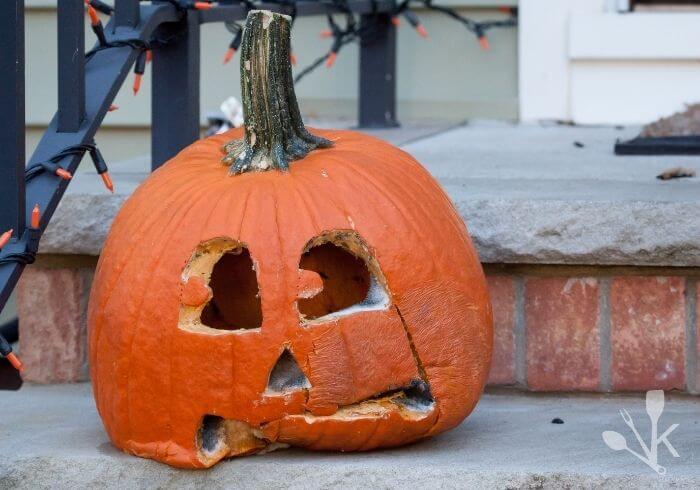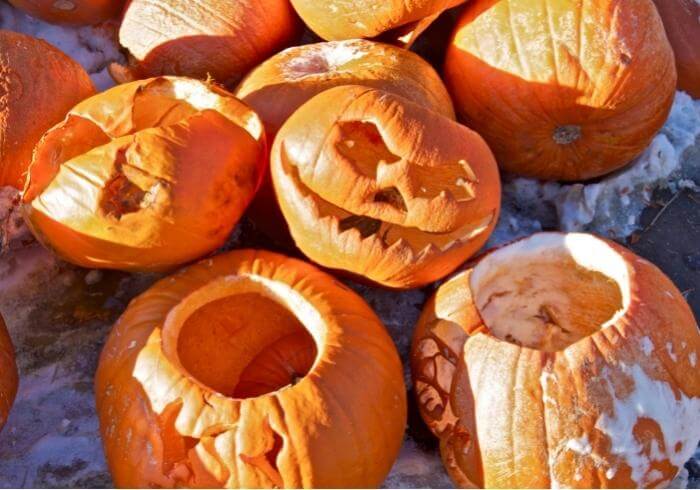As the weather cools and Halloween approaches, you’ll be thinking about your plan to carve a jack-o-lantern. It’s important to choose a good pumpkin, but how do you tell if a pumpkin is bad before you buy it or after it’s been sitting a while at home?
In this guide, you will learn several ways to tell if a pumpkin is bad. Remember that some of these signs may not be present in every bad pumpkin, but if you see several of them, it’s probably best to select a different one or prepare to toss yours out.

7 Signs Of A Bad Pumpkin
Before you even start carving, you need to make sure you’ve selected a good fresh pumpkin. Here are a few signs that indicate your pumpkin is bad or on its way out:
Leaking From The Bottom
When your pumpkin starts leaking from the bottom, you’re too late. This may be the result of not scraping out the inside very well, or just that it’s decomposing and the juices have nowhere else to go except out of the bottom.
The best thing to do is place a large garbage bag on the ground next to it and carefully try to slide the pumpkin on top of it to catch any liquid.
That will at least buy you some time as you figure out the best way to dispose of it.
And trust me, you don’t want stinky pumpkin juice all over your deck, porch, or driveway because it will attract bugs and critters of the night.
Black Mold In Or On It
If black mold is present in or on your pumpkin, it must be tossed out immediately. This is a sure sign that it’s no longer good, and carving it or moving it will only spread the mold around.

Once mold starts growing, there’s no stopping it, so don’t take any chances.
Mold loves to grow in warm juicy places like the inside of ripe pumpkins. So the best way to help deter mold growth is to give your pumpkin a good cleaning on the outside. A water-vinegar bath works well, and don’t forget to dry it.
To prevent a moldy pumpkin inside, scrape the insides well and coat it with a non-flammable spray for pumpkins or petroleum jelly. That will help keep the moisture locked in the rind and prevent mold spores from burrowing into the flesh.
And if you have the space, you should always store pumpkins in a cool, dry place.
Soft Spots
If your pumpkin is soft or has bruises that are soft, you’ve probably got two or three days before it starts to become unpleasant. Overripe pumpkins are soft and will be much easier to carve but have already started to spoil.
If Halloween is still a week or more out, carve your pumpkin and put it in the freezer until you’re ready to put it on display.
Just remember that, like most vegetables, once thawed it won’t be as firm as it used to be and will need to be disposed of within a day.
Started To Smell
If your pumpkin has a strong unpleasant odor, something is wrong, and it must find its way to the garbage or compost pile.
What do pumpkins smell like normally? Whole pumpkins don’t have much smell, but freshly carved pumpkins should have a very light sweetness. Spoiled or rotten pumpkins will smell like a vegetable compost bin.
If the smell of your pumpkin is unbearable, carefully dispose of it. Part of the reason it smells so bad is because of the bacteria or microbes digesting and aiding in the decomposition process.
Discoloration
This could be a sign that your pumpkin is overripe, sick, or has been damaged.
Normal Halloween pumpkin colors include shades of green and yellow as it matures into that spooky orange color. The stems should be green or brownish-green. Sometimes there will be brownish or yellowish coloring where the pumpkin was growing on the ground.
If you notice other colors, it could indicate a problem, such as black mold, white mold, plant diseases, or the natural process of rot.
Shriveling
If a pumpkin looks like it’s shriveling, it could indicate poor storage conditions or that it’s past its prime. It has lost a lot of moisture and may start showing other signs of rot shortly.

I’m sorry, but you can’t soak it in water and expect it to bounce back. It’s already on its way out.
I wouldn’t buy a pumpkin in this state even if it was on sale. It’s just too risky.
Stem Is Dry Or Brittle
A healthy pumpkin’s stem should be greenish-brown and firm and feel like it has moisture in it. Not soaking wet, but something like a tree branch.
If it’s dry or brittle, the pumpkin was likely picked quite some time ago. If it’s not displaying any other symptoms, make plans to carve it up before the end of the week.
Final Thoughts
When you understand your pumpkin’s ailments, you can take action before it becomes a complete mess to deal with.
In the case of molds, get rid of the whole thing immediately, even if it’s outside. Mold spores can get all over you and your clothes. You don’t want to deal with that.
If you’ve picked up a fresh pumpkin and wondering how much time you’ve got, check out this shelf life guide on how long pumpkin’s last.
Happy Halloween!











